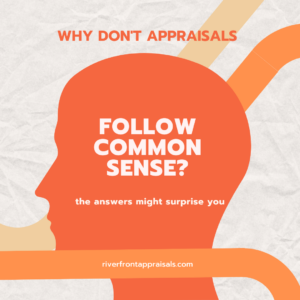
Property Taxes Just Went Up? We’ve Got You Covered!
It’s reassessment season for most folks in our area. Homeowners

Without a doubt, one of the most important factors (and one of the very first) an appraiser must consider when appraising any property is its “highest and best use”. In this blog post, which is part three in our 12-part series on Promoting Public Trust, we will just scratch the surface on this topic. When you’re finished reading, you will have the tools you need to understand the basic concepts of this integral part of the appraisal process.
Before we begin, though, let me insert this one disclaimer: most of what you read here will be directed toward the residential consumer. Our audience consists of homeowners, lenders, and Realtors who primarily focus on residential real estate. That being said, let’s dive in!
I’ve found that when explaining highest and best use (hereafter referred to as HBU), it’s best if we have an example. So let’s assume I’m appraising a one-level home built in 2005. It has 1,800 square feet of living area, a covered front porch, rear deck, three bedrooms and two bathrooms, plus a two-car attached garage. The home is built on a rectangular lot ⅓ acre in size and is located in the Summer Valley Estates Subdivision. Summer Valley is a 100-unit subdivision with all one-story homes with two to four bedrooms and between 1,200 – 2,400 square feet of living area.
One of the most important tasks of an appraiser is to develop an opinion of a property’s highest and best use both as vacant and as improved (if applicable). So as we get started, I want you to imagine a funnel. At the top of the funnel is an almost endless amount of possible uses for any property. The job of an appraiser when developing an opinion of HBU is to take all the potential uses through this funnel, using a series of tests, until at the end of the tests and the bottom of the funnel, what’s left is the ultimate highest and best use of the property.
Highest and Best Use is defined as “The reasonably probable and legal use of vacant land or an improved property that is physically possible, appropriately supported, financially feasible, and that results in the highest value.” The Dictionary of Real Estate Appraisal 6th Edition, 2015.
To arrive at a conclusion of HBU, appraisers employ four tests of physical possibility, legal permissibility, financial feasibility and maximal productivity, and these tests are applied to the property as if vacant, and as improved (if it is).
Using our property example above, we’ll look at each of these tests in some detail. This blog post is intended to provide the reader a brief overview of the subject and is not intended to be a thorough analysis of the subject.
Test #1: Physically possible
We’re starting with a one-level home, built in 2005 from our example above. The first question the appraiser asks is, “what is physically possible here?” What could be built here if there was no home? A small ice cream stand? A parking lot? A doctor’s office? Maybe a home? Perhaps a duplex? What about a 90-unit apartment complex? Since the home already exists, we’ll also ask what is physically possible to do with the improvements. Can we add on? Can we tear down and rebuild? What’s possible?
The answer to these questions usually only weeds out those uses that the site size or shape just won’t allow. Like that 90-unit apartment complex. The ⅓ acre site simply wouldn’t allow that large of an improvement. But there are a ton of other uses that could physically be allowed. So let’s move on to question #2.
Test #2: Legally permissible
Now we take all those physically possible uses and ask the question, “how many of these uses are legally permissible?” To answer this question, the appraiser needs to consult zoning requirements, and see if there are any legal restrictions as to what can or cannot be built on the site. Local building codes may also be reviewed to answer this question.
Let’s assume from our example above, that the site is zoned Residential, and that only one-unit single-family dwellings are legally permitted. There are no other restrictions in the neighborhood dictating what size, style, or type of one-unit dwelling is built. So now we start funneling out some of those earlier possibilities. Out goes the parking lot and the ice cream shop. No doctor’s office for this lot. And – although a dwelling – the duplex isn’t legally permitted because zoning only allows a one-unit dwelling.
Also in this test, we ask if the current improvements are legally permitted? In most cases, the answer is yes, although sometimes we see what we call a legal nonconforming (grandfathered) use. An example of this would be if a 100-year old home on Main Street, surrounded by commercial properties is still standing and is still being used as a residence. The zoning is commercial (which doesn’t allow for residential), but since the zoning ordinance wasn’t developed until 45 years ago, they allowed the home to be used as a residence. You just can’t – per zoning – destroy the home and build a larger home in its place (for example). But let’s get back to our example of the one-level home. Since our home meets current zoning requirements, it is allowed, and since there are no house size or style restrictions, we could also change the appearance or size of the home if we wanted to.
Test 3: Financially feasible
This is where the uses really start to get funneled out. At this stage in the HBU analysis, we take all those physically possible and legally permissible uses, and determine which uses are financially feasible. The easiest and most common ways to test the financial feasibility of a use is by market research/analysis and an analysis of construction costs. Here are a few things an appraiser might consider during this step in the process:
Remember what type of homes are in this subdivision? One-story, two to four-bedroom homes with between 1,200 – 2,400 square feet of living area. So how would the market respond to a 3,500 square foot two-story home with a basement, and a three-car attached garage? Likely not too well. It would be so different from the rest of the homes in the neighborhood, that it might not be feasible to try and sell. If the market value range of homes in this neighborhood is between $160,000 – $350,000, then building a brand new $550,000 home would not be financially feasible. Or, let’s say you were going to stick with a one-level home, but include the highest of high-end finishes and materials. Are these good ideas? Bad ideas? Would it be feasible to tear down this fairly new home and build a new one in its place? Not likely, given the contributory value of the current improvements, plus the high cost of demolition. It also wouldn’t be feasible in this neighborhood to add on a 2,000 square foot addition, even if it was physically possible and legally permissible, because what you’d be left with is a huge over improvement – where you’ll never get back in market value anything near what you’ve spent on it. These are things an appraiser will be considering.
Test 4: Maximally productive
So we began our HBU analysis with a funnel. Any and all uses were up for grabs. But after applying the three above tests of what is physically possible, legally permissible and financially feasible, we’ve narrowed down that list. The potential uses have traveled down the funnel and we’ve been left with just a few. Or maybe just one. Now for the final step in the process: maximal productivity. The use that an appraiser ultimately determines to be the most maximally productive, is the highest and best use.
If I am appraising a property and considering its highest and best use ‘as if vacant’, and I’ve determined from the first three tests that the HBU is to build a single-family residence, then my analysis is complete. The last two tests are usually combined, as most HBU analyses don’t need to go any further. I don’t need to tell the client or homeowner what type of home to be built. Sure, the first two tests will help narrow that down a little, but for the most part, once the first three tests have concluded that the HBU is to build a residential home, then my work is done. And, with our example, the home already exists and passes all of the tests above, so the highest and best use as improved, would be the existing use. We’re not going to add on to it, and we’re not going to tear it down. It fits in perfectly with the neighborhood, and therefore nothing should be changed.
What to look for in your appraisal:
For anyone who is reading an appraisal report, one of the most important things to check for is a complete analysis of the highest and best use. On our residential appraisal forms, there is a box that asks if the present use (i.e. a home) is the subject’s highest and best use. Usually, the box is checked ‘yes’. But that’s not all we’re required to do. Because that’s not an analysis. That’s a conclusion. There has to be a written analysis in the report somewhere, that will guide the reader to learn how the appraiser arrived at his or her conclusion(s). This is where USPAP comes in. USPAP states that “when an opinion of highest and best use was developed by the appraiser, summarize the support and rationale for that opinion.” I’ve seen some rather lengthy analyses, and I’ve seen some that are too short to provide any real meaningful support. Just make sure that the appraiser has taken the time to write out a few sentences, covering each of the four parts of highest and best use, and that their conclusions are logical and well-supported.
[bctt tweet=”For anyone who is reading an appraisal report, one of the most important things to check for is a complete analysis of the highest and best use.” username=”RiverfrontApp”]
If you have any questions about how an appraiser determines a property’s highest and best use, or if you have any other questions regarding residential real estate, contact us today at info@riverfrontappraisals.com. We’ll be happy to help!
Helping homeowners navigate the appraisal process,
Ryan Bays, SRA, AI-RRS

It’s reassessment season for most folks in our area. Homeowners

I feel like we all need a laugh. How about

So this may be a slight break from the norm,
Riverfront Appraisals has been providing comprehensive valuations of residential properties to Western Kentucky and Southwestern Indiana since 2008.